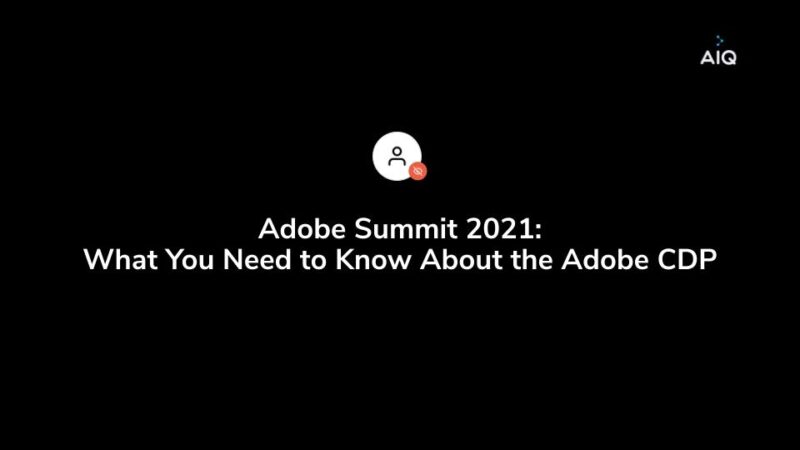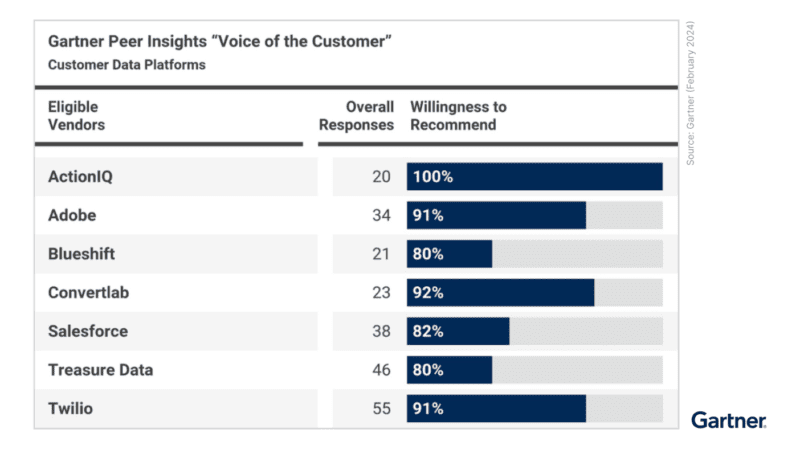What You Need to Know About the Adobe CDP

Adobe teases a compelling vision at Adobe Summit 2021 for customer experience management (CXM), but analysts and customers don’t believe it’s ready for primetime.
Let’s begin by giving Adobe credit where it’s deserving, such as…
- Pulling off a massive Adobe Summit conference, especially in a virtual format.
- Maintaining a handful of market-leading products like Target (site personalization), Analytics (site analytics), Launch (tag management), and Experience Manager (site content management)…See the digital trend?
- Devising a compelling vision that attracts marketing technology buyers with promises of connected customer data and personalized customer interactions.
But beware, they’re behind on fulfilling that vision.
Adobe’s CXM vision is little more than the word itself— a vision. Their actual tools that deliver it aren’t ready for primetime…even if Adobe says they are (evidence below). The company’s attempt to offer a massive technology portfolio has spread them too thin in developing the products themselves, along with the connectivity between them.
Where’s the evidence?
- Evidence #1 — Take Journey Optimizer which raised eyebrows of keen Summit audience members to pepper Adobe in their chat room on whether the tool was just a rebadging of the old Journey Orchestration tool (GA in Dec. 2019)…and why the new tool was still stuck in beta.
- Evidence #2 — Take the “B2B Edition” for AEP. Remember the product was already announced six months ago in fall 2020 and yet still isn’t ready yet. Adobe is confusing buyers by saying it’s available now in their press release, but immediately contradicts itself by saying that it’s available this summer.
- Evidence #3 — Customer success stories are how Adobe parades their products (who better than a customer to tell your story). Where were the major brands on stage talking about how they’re using AEP or RTCDP at Adobe Summit? Instead the few major customers who spoke about these tools simply said they were considering them among other future solutions. The product has been generally available for over 2 years (i.e. no longer in beta) and not one major brand is willing to stand on a table for it?
Adobe’s lack of progress is going to cost you, the buyer.
As you reflect on Adobe Summit 2021, think one step further than everyone else by considering this: Nobody at Adobe is talking about price or the total cost of ownership.
That’s important because…
- Tools aren’t integrated. Adobe’s own product documentation shows the majority of their integrations are in beta. Want more evidence? ActionIQ had to step in and transform Adobe Analytics data in order for Adobe Campaign to be able to use it for one of our customers— something Adobe’s engineers should have solved for a long time ago. This should never happen. All goes to say that it’s no wonder analysts describe Adobe products as only ‘integrated’ as far as sharing common brand names.
- You need to license a ton of tools. Remember what martech experts say when trying to optimize a stack: ‘Look to do more with less. Avoid buying tech that duplicates your capabilities (i.e. paying for things you don’t need).’ The irony here is that Adobe requires you to license 3-5 of their tools to fulfill any single CX use case that a traditional CDP would fulfill. Avoid duplication? Adobe touted Campaign’s ability to segment data at newfound levels of scale, yet also touts Experience Platform’s new segmenting capability— so wait a second…where is segmentation supposed to happen, AEP or AC? Again, more costs for you.
- Their strategy is to lock you in. Due to the need for using so many of their tools and requiring custom integrations among them, it’s no surprise industry analysts say Adobe’s strategy is to lock you into their portfolio. In today’s world, brands are looking to reduce vendor lock-in. Instead of making interoperability easy, Adobe’s contracts discourage buyers from using non-Adobe tools by charging buyers to move data outward to any 3rd party tool.
- Tools require constant data transformations, leading to IT dependence. One of Adobe’s own Experience Platform trainers said it loud and clear, “Data must fit Adobe’s specific XDM format or it can’t be loaded.” What’s the impact on you? Extra resource costs to transform data into each tool’s format ahead of time, along with the risk of missed revenue opportunities.
- Be careful of the bait and switch. Adobe is offering their CDP at below their typical rates to generate adoption. They do this by converting old DMP contracts to their CDP for 1 year at no additional cost. This is a great deal for them as most brands are looking to get out of their DMP contracts with the death of the cookie. But beware when your initial contract is up, don’t be surprised when they present you with the full cost of their CDP. Still new to CDPs? Learn more here: “What is a CDP?”.
So what should you do?
Keep using market-leading digital solutions like Adobe Target, Analytics, Launch, and Experience Manager. They’re great. But take a harder look at the evidence surrounding their CDP’s product adoption, client satisfaction, and analyst reviews— all things requiring you to think beyond the rosy vision they work so hard to create. Talk to analysts. Talk to system integrators. Talk to people with boots on the ground. In short, go beyond the flash of a well-produced marketing event to learn what is vision and what is reality.
Have questions? Contact our CDP experts here.





